SpaceX Successfully Launches Payload Using Recycled Rocket
Another SpaceX success.
SpaceX recorded another success in its efforts to develop reusable rocket technology yesterday when it successfully launched a satellite using a first stage that had already been used on a previous mission:
SpaceX launched a commercial satellite into space on Thursday with the boost of a partly used rocket, a feat that may open an era of cheaper space travel.
A Falcon 9 rocket from SpaceX — formally Space Exploration Technologies Corporation, based in Hawthorne, Calif. — lifted off from the Kennedy Space Center in Florida to deposit the payload, a telecommunications satellite that will service Latin America, in the proper orbit.
What was noteworthy was that the first stage, or booster, of the rocket had already flown once before. It could conceivably launch again, since it returned in one piece, landing on a floating platform in the Atlantic.
“It did this mission perfectly,” Mr. Musk said during a SpaceX broadcast of the launch. “It dropped off the second stage, came back and landed on the drone ship. Right in the bulls-eye.”
A commercial flight employing a reused rocket is a stride toward reducing the cost of sending payload to space, for business ventures like satellite companies in particular. For Elon Musk, the founder and chief executive of SpaceX, replicating this flight with reusable rockets on a regular basis would be a crucial step toward his dream of sending people to Mars.
“It means you can fly and refly an orbital class booster, which is the most expensive part of the rocket,” Mr. Musk said.
Until now, almost all rockets have been single use. Once the fuel is spent, a rocket stage plummets to Earth, a quick demise to a complex machine that cost tens of millions of dollars to build.
Mr. Musk has likened that to scrapping a 747 jet after one flight.
The booster for Thursday’s flight had been part of the rocket that carried cargo supplies to the International Space Station for NASA last April. As the rocket’s second stage and cargo capsule continued to orbit, the booster steered itself back and set down on the floating platform, which is playfully named “Of Course I Still Love You.”
After the platform returned to port in Jacksonville, Fla., the booster was refurbished, tested and deemed ready for another flight. SES, the company that owns and operates the satellite launched Thursday, was the first commercial customer for a Falcon 9 in 2013, and it signed up for the first flight with a recycled booster at a discount from the usual $62 million launch price. Neither SES nor SpaceX has publicly said how large the discount was.
Mr. Musk has suggested that rocket launches could eventually be much cheaper because the cost of rocket propellants is less than 1 percent of the full price for a launch. So if a rocket could simply be refueled like a jetliner for another flight, the cost of space travel could drop to a fraction of what it is now.
How that might play out in practice is still unclear. The same reasoning led NASA to develop space shuttles in the 1970s, but the savings never materialized because of the extensive refurbishment of the orbiters needed between flights. “We were pushing a lot of technology,” said Daniel Dumbacher, a former NASA official who is now a professor at Purdue University.
SpaceX, however, has a better chance. The Falcon 9 was designed from the start to be reusable. Its engines, for example, do not offer cutting-edge performance — but that means they are simpler and more robust, and thus easier, faster and cheaper to get ready for the next flight.
“They’ve taken the right first steps,” Mr. Dumbacher said. “This is where you just have to get out and do it.”
Alex Knapp, a former OTB contributor who now writes for Forbes, explains what all this means for the commercial space industry:
This marks a big milestone for the company, which has been steadily pushing the first stage of its Falcon 9 rocket to the point where it can be reused for years now – since it was founded 15 years ago, CEO Elon Musk said on a conference call following the launch. The primary reason? Cost. Coming in at about $30 million, the first stage of the rocket is the most expensive part.
“I tell my team: imagine there’s a palette of cash that was plummeting through the atmosphere and it was going to burn up and smash into pieces. Wouldn’t you try to save it?” Musk said at the Code 2016 conference last June. “Probably yes.”
Bill Ostrove, an industry analyst at Forecast International, agrees that this will make SpaceX even more cost competitive, in both the short- and long-term.. “Most estimates I’ve seen say that the cost will be lowered by about 30% to launch a payload on a reused Falcon 9,” he said. “This is also an important step towards Elon Musk’s ultimate goal of establishing colonies on Mars. Reusing launch vehicles is a major part of starting to make that more economical.”
At a press conference following the launch, Musk said that they were still working out what the pricing would be for using a “flight-proven” rocket compared to its standard Falcon 9 launch. He did say that it would be a “meaningful” discount over its current price of $62 million. The discount won’t, Musk said, be equal to the total cost savings as the company needs to recoup development costs for the reusable first stage.
The successful launch today is also significant for the industry, notes Jeff Matthews, Director of Venture Strategy & Research at the Space Frontier Foundation. For one reason, it shows that it’s possible to have an relatively fast development cycle in an industry known for long lead and development times.
“In a short 15 months, we have gone from SpaceX sticking the first successful landing of an orbital rocket segment to the first commercial launch with a reused socket segment,” he said. “In the product development cycle for orbital space hardware, that is a significant achievement compared to past programs and SpaceX should be congratulated for aggressively pursuing it.”
Given that it was only a few short years ago that SpaceX was just getting off the ground, this is a pretty extraordinary achievement on their part. In that short period of time, we’ve gone from wondering if they could even get a payload off the ground and to the International Space Station successfully to wondering whether they could successfully retrieve a first stage, which is a crucial part of the company’s business plan since it’s believed that the ability to reuse even just the first stage of the rocket will significantly reduce launch costs. While there were setbacks along the way, including a handful of missions that failed in disastrous ways on the launch pad, they successfully managed to achieve both goals. Now, they’ve proven that they can successfully refurbish and reuse a rocket in another launching and then retrieve that rocket yet again to be used a second, third, or perhaps countless numbers of times. With that established, they have essentially made the case for commercial space launchers, conceivably relieving NASA of a significant duty and allowing them to concentrate on unmanned probes and research vehicles and the eventual return of a manned launch program, something that is currently on track for 2019 or 2020 at the earliest.
SpaceX isn’t resting on its laurels after yesterday’s success either. Within hours after the launch, company CEO Elon Musk tweeted out congratulations to his employees and set another, far more ambitious goal:
Incredibly proud of the SpaceX team for achieving this milestone in space! Next goal is reflight within 24 hours.
— Elon Musk (@elonmusk) March 30, 2017
And today, he mentioned another goal, namely retrieving the heavy rocket used to boost satellites into orbit and cargo vessels on their way to the ISS, an admittedly far more ambitious goal:
Considering trying to bring upper stage back on Falcon Heavy demo flight for full reusability. Odds of success low, but maybe worth a shot.
— Elon Musk (@elonmusk) March 31, 2017
Beyond that, we already know where the company is headed with its next generation of rockets and vehicles, toward the eventual ability to put passengers into orbit. So far, the Falcon 9 vehicle has only been used to carry cargo to the ISS. The eventual goal, though, is for the next generation of this vessel to be capable of carrying a human crew. If successful, this would mean that the American space program would have a way of getting astronauts to and from the ISS without having to rely on the Russians and their Soyuz capsules based on technology from the 1970s. Beyond that, Musk talks extensively about sending a crew to Mars, but that’s clearly something that is still many years away. Some would say it’s an impossible goal that Musk is unlikely to achieve, perhaps they’re right, but people have discounted the viability of SpaceX from the beginning and they’ve been proven wrong at every turn. So I wouldn’t count them out at all.
Photo via SpaceX
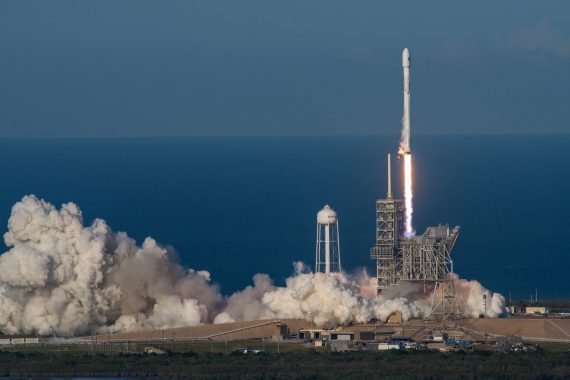

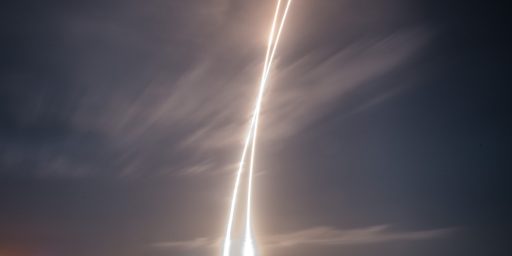
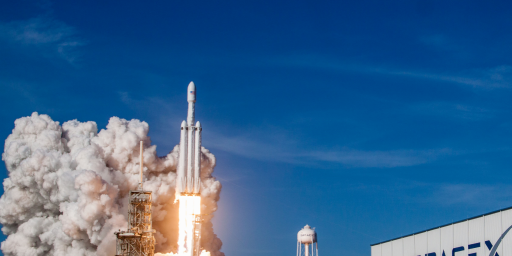
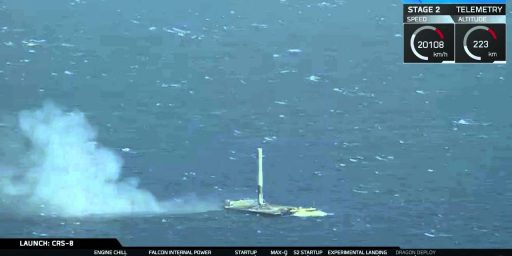
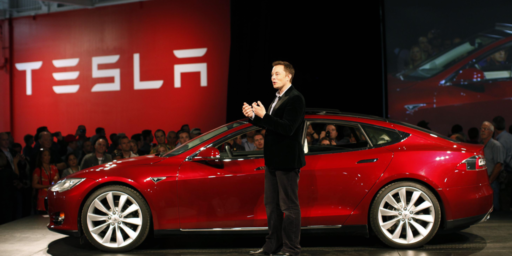
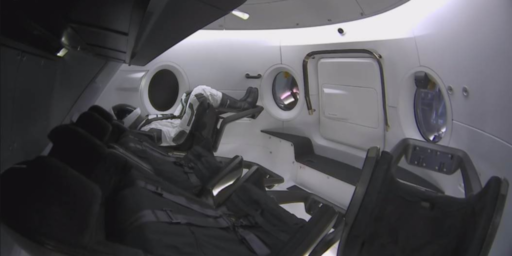
I’ll probably be getting quite an earful on this tomorrow as well as a lot of inside dope. Will post if I hear anything interesting.
Now this really is YUUUUGE…
Amidst all their many failures.
Just saying, ebbs and flows, ebbs and flows.
@Daryl’s other brother Darryl:
We had CNN on at work all day and I wish they were showing the launch. It is YUUUUGE. I’m no rocket surgeon, but a reusable rocket is way bigger than LAPTOP TERRORISM!
Love to watch those Space-X stages land. It looks like something out of a sci-fi movie.
Yeah. from a hardware point of view, it’s great. But Musk’s never really grappled with what it will mean for people to go to Mars and stay there for any length of time. Astronauts on board the space shuttle for months had to be physically helped by ground crew once they returned because they’d lost bone density in space to the point where they needed help walking.
We’re not at warp 9 yet, not by a long shot.
Space is no place for humans, sadly.
This is a big deal, to me. That’s got to drastically lower the cost of orbital flight.
@Barry:
Yep. The biggest cost on any of our astrophysics missions is the launch. If Space-X can do it reliably for 30% less (or more), that could increase the number of missions we start. Mawr science!
@Barry: The first stage is the most expensive. They’re estimating a 30% reduction in total launch costs, so down from $66 million to $46 million. pretty significant, if they don’t have reliability problems.